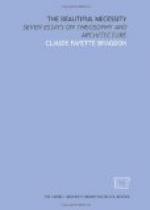[Illustration 35]
[Illustration 36]
First comes the law of Unity; then, since every unit is in its essence twofold, there is the law of Polarity; but this duality is not static but dynamic, the two parts acting and reacting upon one another to produce a third—hence the law of Trinity. Given this third term, and the innumerable combinations made possible by its relations to and reactions upon the original pair, the law of Multiplicity in Unity naturally follows, as does the law of Consonance, or repetition, since the primal process of differentiation tends to repeat itself, and the original combinations to reappear—but to reappear in changed form, hence the law of Diversity in Monotony. The law of Balance is seen to be but a modification of the law of Polarity, and since all things are waxing and waning, there is the law whereby they wax and wane, that of Rhythmic Change. Radiation rediscovers and reaffirms, even in the utmost complexity, that essential and fundamental unity from which complexity was wrought.
Everything, beautiful or ugly, obeys and illustrates one or another of these laws, so universal are they, so inseparably attendant upon every kind of manifestation in time and space. It is the number of them which finds illustration within small compass, and the aptness and completeness of such illustration, which makes for beauty, because beauty is the fine flower of a sort of sublime ingenuity. A work of art is nothing if not artful: like an acrostic, the more different ways it can be read—up, down, across, from right to left and from left to right—the better it is, other things being equal. This statement, of course, may be construed in such a way as to appear absurd; what is meant is simply that the more a work of art is freighted and fraught with meaning beyond meaning, the more secure its immortality, the more powerful its appeal. For enjoyment, it is not necessary that all these meanings should be fathomed, it is only necessary that they should be felt.
Consider for a moment the manner in which Leonardo da Vinci’s Last Supper, an acknowledged masterpiece, conforms to everyone of the laws of beauty enumerated above (Illustration 32). It illustrates the law of Unity in that it movingly portrays a single significant episode in the life of Christ. The eye is led to dwell upon the central personage of this drama by many artful expedients: the visible part of the figure of Christ conforms to the lines of an equilateral triangle placed exactly in the center of the picture; the figure is separated by a considerable space from the groups of the disciples on either hand, and stands relieved against the largest parallelogram of light, and the vanishing point of the perspective is in the head of Christ, at the apex, therefore, of the triangle. The law of Polarity finds fulfilment in the complex and flowing lines of the draped figures contrasted




